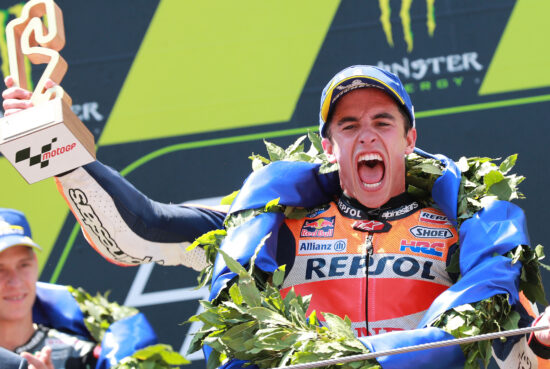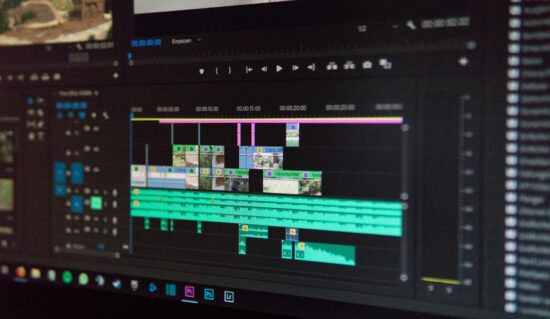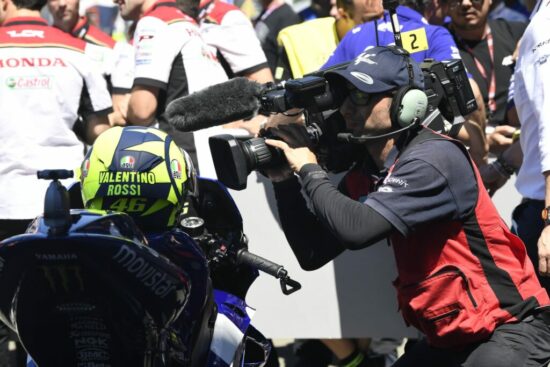With the women’s Football World Cup just wrapped up and the Cricket World Cup in full swing, Dhaval Ponda talks about the transformation of live sports broadcasting to bring brilliant viewing experiences for fans across the globe.

Marc Marquez wins the MotoGP race, Catalunya 2019
What’s the most important quality you think of when it comes to being a sports champion? Is it skill? Raw talent? Or just coincidental moments of genius?
As an ardent sports fan, I believe there are a few traits that cut across all sports and are pre-conditions when it comes to winning. They include team spirit, motivation, focus on continuous improvement, eye for detail and the thirst to win. You can win an occasional contest here and there with individual brilliance, but sustained success is impossible without these traits.
On that note, I want to touch upon another, relatively new but revolutionary aspect of sports broadcasting. Like being a champion, it is becoming a pre-condition for success for broadcasters.
Remote production: a game-changer
 With traditional production, the cost of producing and broadcasting a major sporting event is massive. These costs are driven by the need for a fleet of OB vans at the venue and a big technical team required to keep the operation up and running.
With traditional production, the cost of producing and broadcasting a major sporting event is massive. These costs are driven by the need for a fleet of OB vans at the venue and a big technical team required to keep the operation up and running.
“Remote production has changed all this. It is transforming sports broadcasting by reducing the need for travel and onsite logistical resources.”
It allows a more flexible workflow and enables the seamless transfer of content – while delivering substantial cost savings and efficiencies.
Hitting it out of the park with the IPL
The Indian Premier League is among the top sporting spectacles in the world: 60 matches taking place in 9 cities over 50 days – with a billion eyeballs glued to every bit of the action. The 2018 season was the first time that a sports series of IPL’s scale was produced remotely in India by harnessing superfast connectivity. It enabled the broadcaster Star Sports to capture match feeds from multiple locations and produce customised feeds in eight languages for different regions. All this while keeping the lag and production costs down to a minimum.
Catching the action at high speed with MotoGP
MotoGP is the world’s oldest established global motorsport championship, and it is synonymous with speed, thrill and nail-biting experiences. The 2019 MotoGP season comprises of 19 Grand Prix races spread across Europe, Asia, Americas, Australia and the Middle East.
 With the action unfolding within the blink of an eye, the production of each race needs to be seamless to ensure an exhilarating viewing experience for fans worldwide. To meet this challenge, each of the MotoGP locations uses superfast connectivity and remote production at a broadcast operations hub in Barcelona, Spain. This ensures a reliable distribution of live video feeds from multiple sources including footage from the track, 360° onboard cameras as well as commentary – and, ultimately, a brilliant experience for fans everywhere.
With the action unfolding within the blink of an eye, the production of each race needs to be seamless to ensure an exhilarating viewing experience for fans worldwide. To meet this challenge, each of the MotoGP locations uses superfast connectivity and remote production at a broadcast operations hub in Barcelona, Spain. This ensures a reliable distribution of live video feeds from multiple sources including footage from the track, 360° onboard cameras as well as commentary – and, ultimately, a brilliant experience for fans everywhere.
Live… or truly live?
From motorsports to cricket, social media platforms have brought instant sports updates to fans’ fingertips. This means that they now expect to catch the action live as it happens, without a moment’s delay – even if the race or match might be taking place on the other side of the world.
This puts extra pressure on sports broadcasters. The time it takes for each moment of action to travel across the globe to the remote production centre, followed by its conversion into a single broadcast feed and the final broadcast cannot take more than a few seconds – at best!
“To enable a truly live sports experience, every member of the remote production team has to be like a cog in a fine piece of intricate machinery.”
The on-site team needs to hear instructions and feedback from the production teams as well as have their eyes fixed on the event to capture the action. Real-time communication is critical. All this – the instant enrichment of content and the seamless handover of feeds to the broadcasters’ locations for satellite uplink – is made possible by superfast connectivity.
Innovating to stay competitive
As the likes of Netflix and Amazon are increasingly investing in sports rights there is growing pressure on traditional broadcasters and content owners to keep up with these sports industry newcomers.
 To remain competitive, many are looking to expand their global reach by entering new markets and monetising digital platforms in new ways. Simultaneously, many broadcasters are taking a hard look at how they operate to boost their profitability by reducing overheads, logistical and engineering expenses.
To remain competitive, many are looking to expand their global reach by entering new markets and monetising digital platforms in new ways. Simultaneously, many broadcasters are taking a hard look at how they operate to boost their profitability by reducing overheads, logistical and engineering expenses.
“This is where remote production can make a huge difference, becoming an enabler of business transformation for broadcasters.”
As fans’ appetite for high-quality live content across multiple platforms continues to grow, we look forward to working with more innovative organisations like Star Sports and MotoGP to help them transform how they operate through remote production and bring sports fans the brilliant viewing experiences they crave.
Read our previous blog on how tech brings us closer to the World Cup.
Transformational Hybrid SolutionsOur cloud-enablement services offer the best performance on your traffic-heavy websites or mission-critical applications.
Core NetworksTata Communications™ global IT infrastructure and fibre network delivers the resources you need, when and where you need them.
Network Resources
Unified Communications As A ServiceBreak the barriers of borders efficiently and increase productivity with Tata Communications’ UC&C solutions.
Global SIP ConnectEmpower your business with our SIP network and witness it grow exponentially.
InstaCC™ - Contact Centre As A ServiceCloud contact centre solutions for digital customers experience and agent productivity.
Unified Communication Resources Case studies, industry papers and other interesting content to help you explore our unified communications solution better.
IoT SolutionsThe Internet of Things is transforming the way we experience the world around us for good. Find out more about our Internet Of Things related solutions here.
Mobility SolutionsTata Communications’ mobility services enable your enterprise to maintain seamless communication across borders, with complete visibility of cost and usage.
Mobility & IoT Resources
Multi-Cloud SolutionsWith enterprises transitioning to a hybrid multi-cloud infrastructure, getting the right deployment model that yields ROI can be a daunting task.
Cloud ComplianceCompliant with data privacy standards across different countries and is also designed to protect customers’ privacy at all levels.
IZO™ Cloud Platform & ServicesIZO™ is a flexible, one-stop cloud enablement platform designed to help you navigate complexity for more agile business performance.
Managed Infrastructure ServicesIntegrated with our integrated Tier-1 network to help your business grow efficiently across borders.
Cloud PartnersWe support a global ecosystem for seamless, secure connectivity to multiple solutions through a single provider.
Cloud Resources
Governance, Risk, and ComplianceRisk and Threat management services to reduce security thefts across your business and improve overall efficiencies and costs.
Cloud SecurityBest-in-class security by our global secure web gateway helps provide visibility and control of users inside and outside the office.
Threat Management - SOCIndustry-leading threat-management service to minimise risk, with an efficient global solution against emerging security breaches and attacks.
Advanced Network SecurityManaged security services for a predictive and proactive range of solutions, driving visibility and context to prevent attacks.
Cyber Security ResourcesCase studies, industry papers and other interesting content to help you explore our securtiy solution better.
Hosted & Managed ServicesTata Communications provide new models for efficient wholesale carrier voice service management. With our managed hosting services make your voice business more efficient and better protected
Wholesale Voice Transport & Termination ServicesYour long-distance international voice traffic is in good hands. End-to-end, voice access & carrier services which includes voice transport and termination with a trusted, global partner.
Voice Access ServicesTata Communication’s provide solutions which take care of your carrier & voice services, from conferencing to call centre or business support applications.
Carrier Services Resources
CDN Acceleration ServicesOur CDN Web Site Acceleration (WSA) solution helps deliver static and dynamic content, guaranteeing higher performance for your website.
CDN SecuritySafeguard your website data and customers’ information by securing your website from hacks and other mala fide cyber activities.
Video CDNDeliver high-quality video content to your customers across platforms – website, app and OTT delivery.
CDN Resources
Elevate CXIncrease customer satisfaction while empowering your service team to deliver world-class customer experience and engagement.
Live Event ServicesTata Communications’ live event services help battle the share if eyeballs as on-demand video drives an explosion of diverse content available on tap for a global audience.
Media Cloud Infrastructure ServicesTata Communications’ media cloud infrastructure offers flexible storage & compute services to build custom media applications.
Global Media NetworkTata Communications’ global media network combines our expertise as a global tier-1 connectivity provider with our end-to-end media ecosystem.
Use CasesUse cases of Tata Communications’ Media Entertainment Services
Remote Production SolutionsMedia contribution, preparation and distribution are highly capital-intensive for producers of live TV and video content, and their workflows are complex.
Media Cloud Ecosystem SolutionsThe Tata Communications media cloud infrastructure services offer the basic building blocks for a cloud infrastructure-as-a-service.
Global Contribution & Distribution SolutionsTata Communications’ global contribution and distribution solution is built to reduce capital outlay and grow global footprint.
Satellite Alternative SolutionsAs more and more consumers choose to cut the cord & switch to internet-based entertainment options, broadcasters are faced with capital allocation decisions.
LeadershipA look into the pillars of Tata communications who carry the torch and are living embodiment of Tata’s values and ethos.
Culture & DiversityHere at Tata Communications we are committed to creating a culture of openness, curiosity and learning. We also believe in driving an extra mile to recognize new talent and cultivate skills.
OfficesA list of Tata Communications office locations worldwide.
FAQCheck out our FAQs section for more information.
SustainabilityOur holistic sustainability strategy is grounded in the pillars of People, Planet and Community with corporate governance at the heart of it.
BoardHave a look at our board of members.
ResultsFind out more about our quarterly results.
Investor PresentationsFollow our repository of investor presentations.
FilingsGet all information regarding filings of Tata communications in one place.
Investor EventsAll investor related event schedule and information at one place.
GovernanceAt Tata, we believe in following our corporate social responsibility which is why we have set up a team for corporate governance.
SharesGet a better understanding of our shares, dividends etc.
SupportGet all investor related contact information here.



